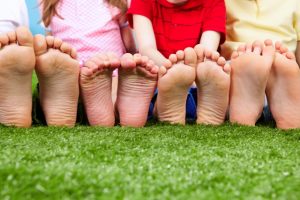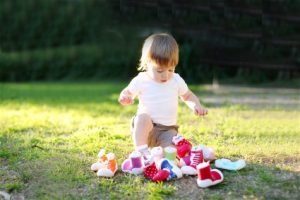It’s never too early to be concerned about your child’s foot care. Children’s feet are often overlooked. Children with strong, healthy feet often avoid many kinds of lower extremity problems later in life. Children’s foot care is mainly a matter of keeping an eye on any abnormalities, and not ignoring your kids when they say something hurts.
General Foot Care Tips For Infants and Toddlers
Infants and toddlers are continually growing. As such their feet and legs are always changing. It’s important not to allow too much strain or pressure on the feet that it will affect the shape. Make sure all shoes and socks do not compress or squeeze the toes together too tightly.
Although it’s exciting to look forward to your baby’s first steps, do not rush a baby into walking before they are ready. Once they do start walking observe their gait for anything unusual. Many toddlers have a pigeon-toe gait which most children outgrow. Cut toenails straight across and not too short. Don’t ever curve them because this can encourage ingrown toenails.
Choosing Shoes For Your Toddler
Once your baby starts walking you may decide to get some shoes. Shoes for babies are mainly to protect their delicate feet from dangerous surfaces. Unless shoes are required for protection, having your toddler walk barefoot at home is the best choice in order to develop strong foot structures. If you do put on shoes, they should be soft-soled with a non-slip surface. Choose shoes with natural linings such as leather and socks with a high natural fibre content to allow feet to breathe. Shoes should be light and flexible, containing a sole that doesn’t curve in at the instep and a firm heel cup. It is best not to put their child’s feet in hand-me-downs, as you may be exposing them to someone else’s faulty foot mechanics.
Check your child’s shoe size often to make sure they haven’t outgrown their current shoes. Make sure there’s space between the toes and the end of the shoe, and make sure his or her shoes are roomy enough to allow the toes to move freely. Also, get socks that fit the foot. Socks that are too tight will cramp the foot and can even deform it in very young children. Conversely, socks that are too big can bunch up and cause blisters.
Common Children’s Foot Conditions
There are some common conditions that most children outgrown with time without intervention. Some of these are bowlegs (when legs curve outward below the knee). If they do not correct themselves by age two, or if only one leg is affected, you will want to have us evaluate them. It may be a sign of more serious conditions such as rickets and Blount’s disease.
Knock-knees is when the legs bend inward at the knee joint and is be quite common in 3 to 6-year-olds as their body alignment changes. Only rarely will this condition need treatment, as children usually outgrow it as their bones and muscles mature.
Many babies toe walk when they first start walking. This usually remedies itself before the second birthday. Even older children may occasionally revert to toe-walking on and off, but if they continually do so, or do it only on one leg, they should be observed for muscle or nerve problems. In rare cases, persistent toe-walking can be a sign of another condition like cerebral palsy or muscular dystrophy.
Most infants have flat feet when they are born. The arch begins to form as they start walking and is usually formed by age 5 or 6, unless they have an arch structure that will remain flat throughout their lives, which is fairly common. Flat feet aren’t usually a problem unless they are painful. Flatfooted children can run and play and participate in sports like other kids.
Certain conditions may or may not need intervention along the way, including clubfoot, cavus foot or flat foot, in-toeing or out-toeing, tarsal coalition, and Sever’s disease. Unless the cases are severe or extremely limiting, your child will likely outgrow many of these problems without treatment as they get older.
Children’s Foot Injuries
One thing you will want to watch for carefully is children’s foot injuries. Because kids’ bones are still forming and hardening, they are more susceptible to fractures than adults, especially if they are active in sports. Watch for tendon problems, as well as any symptoms of sprains. Sometimes children cannot identify their pain, but you may notice symptoms of limping or not wanting to put weight on a limb. Little aches and pains are a part of growing up, but have them checked out if they continue.


